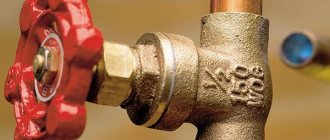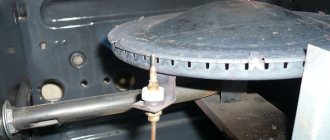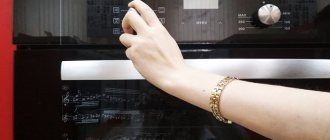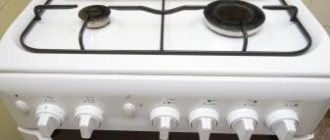The vast majority of owners practice repairing gas stoves on their own. Despite the strict prohibition of inspectors and linemen of local Gorgazov on interfering with the operation of gas appliances, amateur repair of the stove gives a good result and at the same time allows you to save a lot of money. A locksmith, without blinking an eye, will charge 50-100 dollars for repair work.
We stock up on tools to carry out repairs
To repair gas stoves at home, you will need a minimum number of tools, first of all:
- A universal screwdriver with interchangeable bits - a cross and a standard straight slot, pliers;
- Small adjustable wrench with side lip extension of 15-20 mm;
- Fum tape for gas appliances;
- Solid gas lubricant;
- Soft brush and highly effective detergent.
You can take “CIF”, “Cleaner” or any other liquid gel used to clean gas stoves with a stainless base from burnt-on fat. Sometimes, in extremely rare cases, you have to use a multimeter to repair a stove.
And, of course, you will need good health, at least there should be no runny nose, otherwise it will be difficult to detect a gas leak, and when working with gas appliances, the main condition for success is work safety. For the most serious work with coupling joints in a gas stove, you will need a watercolor brush and diluted liquid soap.
Cracks after a fall
Remote controls can be located in a variety of places, as they should always be at hand: after waking up, you look for the remote control on the bedside table, when you have breakfast, the device lies with you on the table, and during an evening movie show, the remote control moves to the sofa next to you.
They are compact and comfortable, but they fall quite often, and this does not always happen on soft carpet. If the remote control is dropped on ceramic tiles, it can suffer serious damage not only to the outer case, but also to the internal microcircuits.
If after a fall the remote control ceases to function, then its restoration also begins with disassembly. There are three common damage caused by impact:
- Broken LED;
- The battery terminal is broken;
- The quartz resonator is damaged.
The first two faults can be determined by visual inspection. The operation of the LED can be checked without even disassembling the housing:
- Turn on the camera on your smartphone.
- Point the remote control at the camera so that the LED is in focus.
- Look at the mobile phone screen and press any button on the remote control. The signal, if any, will be clearly visible through the camera.
You can also check the operation of the LED using a multimeter, but to do this, the outer parts of the housing will have to be removed:
- Connect the tester probes to both ends of the LED.
- Set the device switch to 3V.
- Press any button on the remote control.
- If the tester shows voltage, then the LED is working.
After an unsuccessful fall of the remote control, the contact terminal of the batteries may be damaged. The spring contacts of this connection are soldered to the chip, so make sure that the soldering is not broken and is firmly in place. Also check the springs themselves for corrosion or bending. If the contacts are oxidized, you can clean them with sandpaper.
If you find ring cracks or oxidation in the soldering of the contact terminals and decide to solder them again, then the correct thing to do is to disconnect all the elements from the board, clean and tin them, and only then solder them again.
But checking the performance of a quartz resonator is not so easy. To do this, you need to disassemble the remote control and find on its microcircuit a small box with soldered contacts. If you gently shake it and hear the sound of crumbs rolling inside, then the resonator is broken and will need to be replaced. Only a master can revive such a bullet.
If the TV remote control was dropped on the floor and immediately after that you noticed that the device stopped working, then when disassembling the remote control you should pay attention to the ceramic resonator.
Gas stove breakdown options
It is known from practice that the better the quality of the gas stove, the fewer reasons there are to disassemble and repair. Appliances manufactured in the CIS begin to break down after 3-4 years from the moment of commissioning, Turkish gas stoves can withstand 5-10 years of operation, German and Italian ones require repair no earlier than 12-15 years of service.
The most common failure cases:
- The electric ignition of the burners does not work, one or all at once;
- The automatic control of the burner flame front does not work;
- The smell of gas appears;
- Malfunction of the flame level regulator.
Of the above set, the most serious problem is considered to be gas leakage. If the smell of gas does not disappear when the gas stove is not working and the central tap is open, you will need to coat all joints and connections, from the supply hose or pipe to the regulator tap and nozzle.
Advice! If you are not sure that you can perform this type of diagnostics and repair yourself, then it is best to seek help from a specialist.
The batteries are low
80% of all calls to service workshops regarding a broken TV remote control are caused by batteries. The first thing to do when diagnosing failures of the remote control is to replace the batteries with new ones.
Even if you only installed new batteries a few days ago, you should try updating them. Batteries may be defective or expired; often, even in original packaging, these elements may be “dead.”
If you have a voltmeter in your house, you can check their voltage with this device. The minimum charge value should be 1.3 V. If the battery potential is lower, it must be replaced.
Check the operation of the remote control with new batteries; further repairs may not be required. If they are not the reason, move on to the next stage.
We repair a gas stove with our own hands
In a situation with a gas leak, there is nothing extraordinary; repairs can be done on your own, but you will need to take precautions, remove open sources of fire, organize a small draft in the kitchen, and use a hand-held battery-powered flashlight instead of stationary lamps.
Eliminating the smell of gas
First of all, to repair the gas system, you need to find the location of the leak. Most often, gas escapes through the windings on the couplings or union nuts of the hose with which the stove is connected to the outlet from the main tap. If the stove is made in the CIS countries, then gas can siphon through the nuts on the internal tubes running from the regulator valves to the burners. The third place of possible leakage is the gas supply regulators to the burners themselves.
To determine the location of gas leakage, you will need to apply a water-soap solution with a brush to all threaded pipe connections without exception. A leak can be detected by slowly rising bubbles. There is no other way to determine the location of the repair, except perhaps with the help of a special gas tester.
To repair, you need to turn off the gas valve and repack the joint with fum tape and gas lubricant. Inside the slab, paronite or silicone gaskets are used at all pipeline connection points, providing a very reliable and high-quality seal.
If the smell of gas occurs during operation of the gas stove, then the nozzle system with an air intake and flame divider is subject to repair. During repairs, the injectors must be cleaned with a cut match or a plastic needle. The air intakes are checked for the presence of dust or foreign objects, and the dividers are cleaned of settled gas combustion products with a thin wire.
Repair of faucet regulator
For gas stoves produced in the CIS countries, the most common breakdowns are the regulator taps. Such a valve is made in the form of two parts - a stationary body and a movable cone-shaped liner with holes. The cone is pressed by an insert spring and a drive rod, onto which a plastic burner control handle is placed.
The parts are made of brass; according to the technology, the cone must be ground into the valve body. If the valve parts were operated without lubrication, natural wear or wear on the cone would occur.
For initial repairs, you need to unscrew the two mounting screws and remove the cone, having previously marked its position relative to the body with a marker. Next, you need to remove the dirt, add a small amount of solid gas lubricant and reassemble the assembly in the reverse order. Such simple repairs can extend the life of a gas stove by several years.
Repair of cranes is carried out one at a time so as not to confuse the parts with each other. No other lubricant other than special gas can be used, otherwise the faucet will stick so that it can only be turned with pliers with enormous force.
For Italian or German stoves, faucet repair is generally irrelevant; thanks to the high quality of the metal and lubricant, the device can operate trouble-free for 15-20 years.
Correct repair of the electric ignition system
Most often, modern gas stoves are sent for repair due to a disruption in the stable operation of the built-in electric ignition system. In many cases, a complete failure does not occur; ignition may not work on one burner, or it may periodically appear and disappear alternately on several burners.
The system itself consists of four main elements:
- Contact pair installed on the control handle;
- Power supply systems, which include an ignition unit, a surge protector and a cord for plugging into an outlet;
- Four spark plugs, one for each burner;
- High voltage wires.
The latter are used to connect the spark plugs to a block-generator of high-voltage electrical pulses, one for each spark plug. The body of the gas stove acts as the second conductor of the high-voltage circuit.
Ignition repairs begin with disassembling the gas stove. Initially, remove the burners and remove the front top cover of the gas stove.
Ignition does not work on one burner
In the vast majority of cases, repairing electric ignition comes down to eliminating the short circuit between the high-voltage wire and the housing. The technological cavity located under the front cover is used for laying pipelines and wiring in the slab.
During the cooking process, water and some of the contents of pots and pans get inside the cavity and accumulate for a long time. Liquid substances, which most often have an acidic reaction, conduct current well, so even one drop that gets between the wire and the body can cause the auto-ignition to be repaired.
For high-quality repairs, all high-voltage wires must be cleaned, dried, placed in PVC tubes and fixed on plastic stands, without contact with the metal body of the gas stove.
In addition, heavily soiled spark plugs may be a reason for repair. The deposited grease deposits close the circuit, which leads to blocking the operation of the high-voltage unit of the system.
To perform repairs, you must perform the following manipulations:
- Remove the contact connector from the spark plug;
- Use a screwdriver and pliers to remove the retaining leaf spring and remove the spark plug;
- We wash the part in a strong detergent solution, clean, dry and install it in its original place, put on the connector.
For your information! Despite the assurances of gas mechanics, in approximately 95% of cases, problems with ignition operation do not require major repairs with replacement of the block, spark plugs or wiring.
Repairing stuck ignition on a gas stove
A situation occurs when the automatic ignition system begins to operate even when the burner control handle is released or turned off. The cause of the emergency is a short circuit of the control wiring to the body of the gas stove.
To repair, you first need to turn off the power to the gas stove. The next step is to remove the top panel and clean all high-voltage wires from dirt. If the unit is working properly, then the steps performed are sufficient for the initial repair of the device. It is imperative to clean and dry the entire technological niche of the stove.
Sometimes it happens that after releasing the burner handle, the spark plug continues to click for quite a long time. The reason for this situation is that the rotating mechanism of the faucet is heavily contaminated with grease, as a result of which the force of the return spring is not enough to open the contacts.
To repair the burner, it is necessary to remove dirt and lubricate the mechanics with a mixture of VD5.
The cost of carrying out work by specialists
Malfunctions occur suddenly and require quick fixes, especially when a gas stove breaks down. However, not all home appliance owners have the necessary skills. When it is impossible to carry out repairs yourself, you have to call a specialist to your home. What expenses await the owner:
- replacement or repair of a gas supply valve - from 300 to 1,200 rubles;
- nozzle cleaning - from 400 rubles;
- replacing the oven lamp - from 400 rubles;
- gas adjustment - from 500 to 900 rubles;
- lubrication and cleaning of rods on the feed lever - 900 rubles;
- replacement of rods - 1200 rubles;
- thermocouple replacement - 900 rubles;
- replacement of the ignition unit - 900 rubles;
- cleaning of supply contacts - from 900 to 1,100 rubles;
- change of sealing gum - from 500 rubles;
- replacement or repair of a spark plug - 800 rubles.
Prices depend on the stove model and the region where household appliances are serviced and repaired.
Malfunctions in the burner operation control system
Modern gas stoves are necessarily equipped with flame front control systems. A thermocouple tongue is installed on the burner, which receives heat from the flame. A heated thermocouple produces a small voltage at the contacts.
When the burner is turned on, the handle is recessed by 3-5 mm, which leads to the fixation of the opening tap on the electromagnet built into the housing. While the magnet receives voltage from the thermocouple, the gas valve remains open.
Repairing the control system is completely similar to the procedure for restoring the ignition system. Most often, the thermocouple is covered with a thick layer of deposits that interfere with the heating of the sensor. All repairs boil down to thoroughly cleaning the thermocouple and installing it in the socket.
Experts also recommend cleaning the contacts on the connecting wiring; the voltage is low, so even a thin layer of fatty deposits on the connectors can damage the system.
see also
Comments 9
It misses exactly where this bushing is - The etching is obtained directly from the handle of the twister... the plate is zero! Is lubricant used for sealing? Which one is needed exactly?
Read the post above... The easiest thing to clean and lubricate is with graphite. Since the stove is new, perhaps the lubricant has not yet been developed, or it was not installed at all. Or the handles are mixed up. It’s just that each faucet has its own handle, and you can’t mix it up.
Find where the spool turns, the problem has been found! Too much pressure! Instead of 0.05 it was 0.3. the gearbox is in the trash, I installed a regular frog
If necessary, the burner valves are lubricated with lubricant LG-GAZ-41 (TU 38 101644-76), LS-II (TU 38 Ukrainian SSR 201145-73), NK-50 (according to GOST 5572-67), Klad-M (TU 0254-001 -42229024-99), Germeton (Poland), Germetil (TU 0254-023-56194358-2008 amended 1) or Molykote 1102. In Soviet instructions for slabs, relubrication is recommended every three years.
For old-style slabs, any of the above lubricants is suitable. For modern stoves, Germet lubricant produced by the Shaumyan Plant (St. Petersburg) or Molykote 1102 is recommended.
Solid oil and technical petroleum jelly can be used to lubricate burner taps when specially designed compounds are not available. Without disassembly, machine oil can be dripped into the burner tap from a pipette.
In slabs produced in previous years, the tap is lubricated in the following order. Unplug the stove's power cord from the outlet. Using a plug tension valve on the gas pipeline, close the access of gas to the burner taps of the stove. Insert a screwdriver between the shield and the handle and tighten the handle. Remove the screws securing the shield. Turn out the locking screw (if the edge of the table interferes with this, separate it by unscrewing the screws). Remove the rod and plug by using a screwdriver to pry it behind the oval hole through which the locking screw passed. Remove the spring from the plug. Wipe the plug and the contacting surface of the body with a cloth soaked in kerosene (solvent, triple cologne, etc.), removing any remaining grease. Wipe the conical surfaces dry and apply a thin layer of lubricant to them. Insert the plug into the body and turn it several times with a screwdriver through the oval hole for the locking screw. Remove the plug and clean the drillings through which the gas enters from the lubricant covering them (it is advisable to use a bend of thin wire to clean the stoma of the hole in the housing for the passage of gas). Return the plug to the body so that the oval hole is located opposite the slot in the body. Insert a rod with a spring into the plug so as to tighten the locking screw. The rest of the assembly is performed in the reverse order of disassembly. It should be remembered that each body has its own plug.
Resuscitation of buttons
Graphite conducts electricity well. If the graphite coating on the rubber button plate has worn off, you can replace it with a ready-made Chinese part. However, the cost of the part can be compared to the price of the whole remote control. In order not to waste money, you can repair the remote control at home.
Take:
- Foil from a pack of cigarettes, or any other foil on a paper backing.
- Good silicone based glue. You can use "Moment". There is no point in buying special glue for a one-time repair of the remote control.
- Scissors. Using scissors, you will cut out small geometric shapes from foil that match the shape of the remote control buttons.
If possible, you can buy a repair kit at a specialized store. The set includes ready-made buttons with conductive graphite coating and glue for attaching them.
How to repair the remote control:
- Disassemble the remote control;
- Take out the rubber button element;
- Place pieces of foil on the bottom of the non-functioning buttons. Place the paper side of the foil on the glue.
Repairing remote controls for Samsung smart TVs follows the same principles as work on devices from other brands. As you can see, repairing remote controls yourself is not a difficult task. It is enough to understand the general structure of the product. If you have an idea of how the remote works, you can effectively fix it yourself.
Repairing television remotes yourself is not always worth the associated hassle. Sometimes it is better to entrust remote control repairs to specialists.
A horizontal black stripe appeared on the TV screen
Disassembling the Samsung TV remote control
Setting up a huayu universal remote control for your TV
TV does not respond to remote control commands
If neither cleaning nor replacing batteries helps, the remote control is visually intact, but the TV does not respond to its commands, you should check the condition of the electronic part. To do this, the remote control is disassembled. When troubleshooting, you need to act carefully and carefully.
Lost contacts
When remotes are dropped or simply over time, a variety of devastating consequences can occur. After disassembling the remote control, inspect:
- area of the LED, the state of its legs;
- wires from the battery compartment, their condition, strength of soldering to the main board;
- condition of other parts with legs.
If breaks or broken conductors are found, repairs with a soldering iron or complete replacement of parts with damaged contacts are necessary.
Advice! It would not be superfluous to inspect the back surface of the electronic board. In places where the ends of the component legs have sunk deep, it is worth adding tin and working with a soldering iron.
Troubleshooting
During the initial visual inspection, most simple problems are detected and eliminated. If this does not help restore the operation of the remote control, it is worth checking the condition of some electronic components of the board. They start with an LED. Batteries are inserted into the power compartment. You will need a smartphone to check. The camera starts on it. The remote is pointed at her lens. If the LED is working properly, when you press the buttons, the smartphone, whose camera also captures waves invisible to the eye, will clearly display flashes. If the element is broken, the user will not see anything.
The second difficult problem is the failure of the quartz resonator necessary to generate a signal for the TV. Some manufacturers place this element in different parts of the electronic board. Therefore, you will have to determine the breakdown by ear. The board is gently shaken near the ear: if a rustling sound is heard, as if from rolling grains of sand, it means that the resonator is damaged and requires replacement . You can do this yourself or take the remote control to a workshop.
Common problems
The rules for operating the remote control are specified in the technical documentation of the TV or a description of the device can be viewed on the website of the producing brand.
To read the features and characteristics of the control device, just enter the serial number and open the “Manuals and Specifications” section, where you will see the tab responsible for setting up the remote control.
If the remote control is working properly, then when you press the signal indicator at the top of the device, it should flash red. Otherwise, it is necessary to diagnose the device.
Standard problems associated with the operation of the remote control are:
- The TV does not respond to the on/off signal.
- The light indicator has stopped working.
- The LED at the top blinks at a certain frequency.
- The volume cannot be adjusted.
- The channels stopped changing.
In order to understand the cause of the breakdown, you must:
- Remove both batteries from the device.
- Press any button on the remote control and hold it for about 20 seconds.
- Release the key and reinsert the batteries.
If the remote control does not respond, then there may have been a glitch that was corrected when you turned on the TV.
Many remote controls rely on an infrared signal transmitted over a distance. When it is blocked, you will have to diagnose the area between the remote control and the TV.
This way you can understand whether anything is interfering with signal transmission. This could be furniture, books, things left in front of the TV.
Distance also matters. If the remote control malfunctions, you need to come close to the TV and check the operation of the switch by pressing any of the buttons.
Important! The user manual specifies the required distance from the receiver to the TV. Pay attention to this point if the remote control directed to the center of the screen does not work, while the switch directed to the corner of the monitor catches the signal without problems.
Remote control device
All remote controls have a similar design. Main components:
- Frame. Consists of two halves, glued or twisted.
- Printed circuit board. The board contains a small microcircuit, a few more radio elements, an infrared LED, battery compartment contacts and a contact pad in the form of conductive tracks.
— Rubberized pad with buttons.
- Batteries.
This is interesting: Why the dishwasher does not wash dishes well: causes and repair of the malfunction











